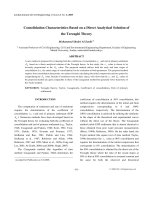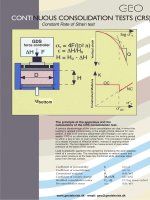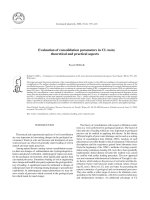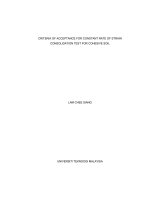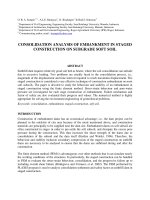Continuous consolidation tests (CRS)
Bạn đang xem bản rút gọn của tài liệu. Xem và tải ngay bản đầy đủ của tài liệu tại đây (1.33 MB, 2 trang )
www.geoteknisk.dk
.
email:
The principle of the apparatus and the
calculations of the CRS consolidation test.
A serious disadvantage of the usual consolidation on clay, in which the
loading is applied incrementally, is the length of time required for com-
pletion. A test in an ordinary oedometer cell (Terzaghi) can take up to
weeks. CRS is an alternative method, which reduces the testing period
to within a day or two, or even a few hours. This procedure makes use
of a steady increase of effective stress, instead of applying stress
increments. The test depends on the measurement of pore water
pressure at the base of the sample.
Load is gradually applied to the sample by increasing the axial displace-
ment at a constant rate. The resulting increase in vertical stress and
pore water pressure at the base are monitored while drainage takes
place from the top surface.
CONTINUOUS CONSOLIDATION TESTS (CRS)
Constant Rate of Strain test
Vertical strain
Constrained Modulus
u
bottom
GDS
force controller
Coefficient of permeability k (m/s)
Coefficient of consolidation
c
v
(m
2
/s)
Constrained modulus
K (kN/m
2
)
Coefficient of volume change
M
v
=1/K
(m
2
/kN)
Modified consolidation index
C
ce
=Q (%/log stress cycles)
Pre-consolidation stress s
‘
pc
(kN/m
2
)
EXPERTS IN SOIL, WATER AND THE ENVIRONMENT
2003-02-01/JCL
Product sheet
Geo
Maglebjergvej 1
2800 Lyngby
Denmark
Tel.: +45 4588 4444
Apparatus:
The sample is confined in a loose steel ring, which prevents horizontal
deformation, and reduces friction in the apparatus. The test is carried out
on samples with diameter, D, and height, H, where DxH = 60 x 30 mm.
A GDS actuator controls the vertical stress and strain. A force transducer
placed at the end of a piston measures the force. Pore pressure is
measured at the base filter stone where the drainage valves are closed.
Procedure
Load is gradually applied to the sample by increasing the axial displace-
ment at a constant rate. The resulting increase in vertical stress and pore
water pressure at the base are monitored while drainage takes place
from the top surface. Some assumptions must be made at the outlet in
order to select a suitable rate of strain, which should generally give
excess pore pressure in the range 3% to 20%.
Calculation
The CRS test is based on Wissa's solution (Wissa et al 1971). Where the
average internal strain rate, r, is calculated from the external strain:
where
De
average
is the mean strain corrected for the self deflection of
the apparatus. The vertical mean effective stress,
s
v,average
, is:
The constrained modulus is determined as a tangent parameter, K
t,
from
the increase in the effective stress and strain:
The coefficient of permeability, k, is calculated from:
The coefficient of consolidation, c
v
, is calculated using k and K
t
:
Reference:
Wissa, A.E.Z., Christian, J.T., Davis, E.H. & Heiberg, S. ( 1971):
Consolidation at Constant Rate of Strain. ASCE Vol.97, No.SMIO, pp.
1393-1413 and "Swedish Standard SS 027126 CRS Oedometer Test on
Cohesive Soil".
G-PR-UK-008-02
Vertical strain
Constrained Modulus
u
bottom
GDS
force controller
De
average
r =
Dt
D
s
’
v,average
K
t
=
D
e
average
2
s’
v,average
= s
v
=
u
bottom
3
rH
2
g
w
k
=
2u
bottom
kK
c
v
=
g
w
3
Employing some of the country’s highest qualified engineers, GEO offers Denmark’s most comprehensive expertise
within the areas of soil, water and the environment.
At GEO, specialists are working with soil mechanics and foundation engineering both offshore and land-based, as
well as laboratory and field testing, soil and groundwater contamination, hydrogeology, drilling and groundwater
technology.
GEO solves some of the largest and also the most complex construction tasks in Denmark. GEO also ensures that
Danish one-family houses are founded on solid ground.
GEO is there when excavations need to be made, procures clean drinking water and solves problems caused by
contaminated soil or groundwater.


